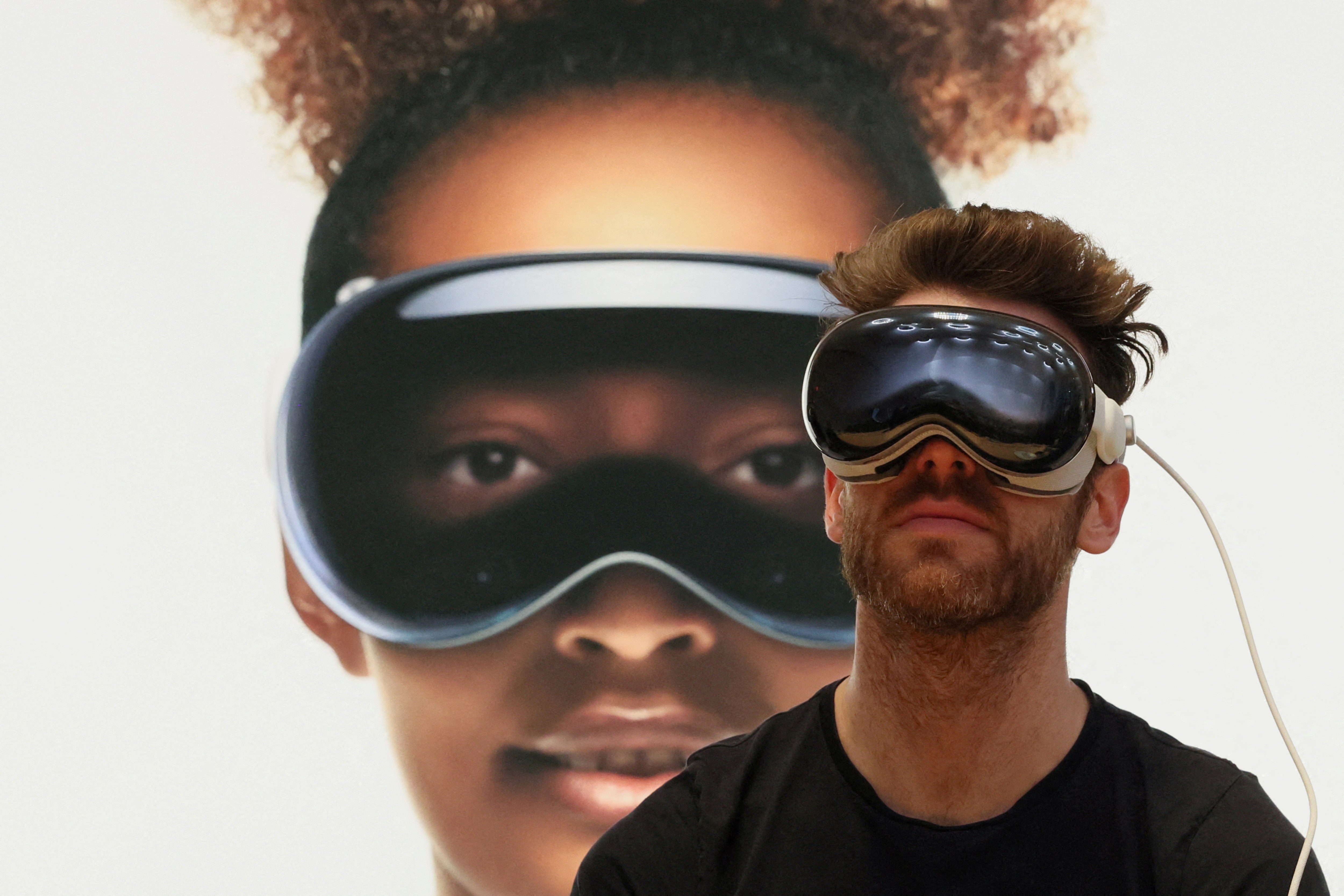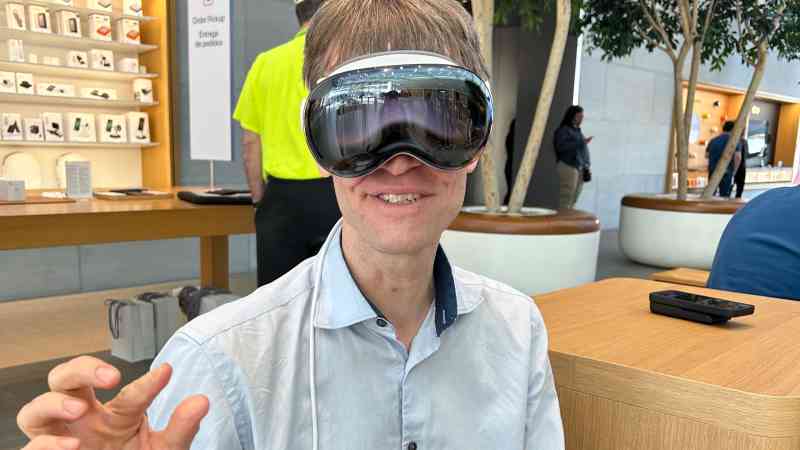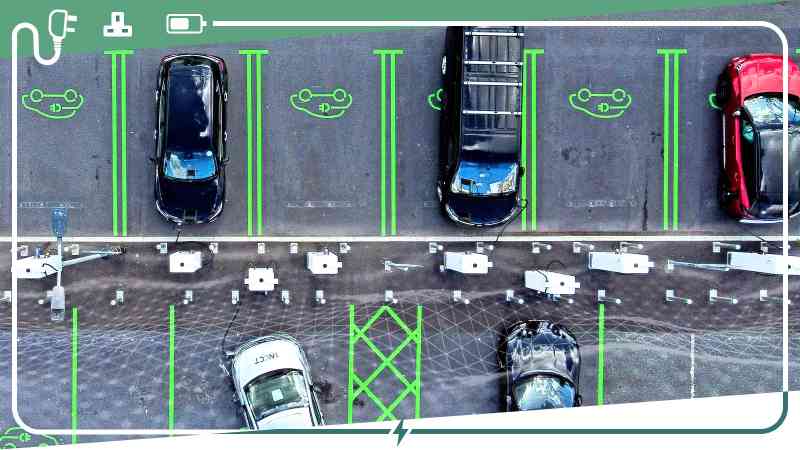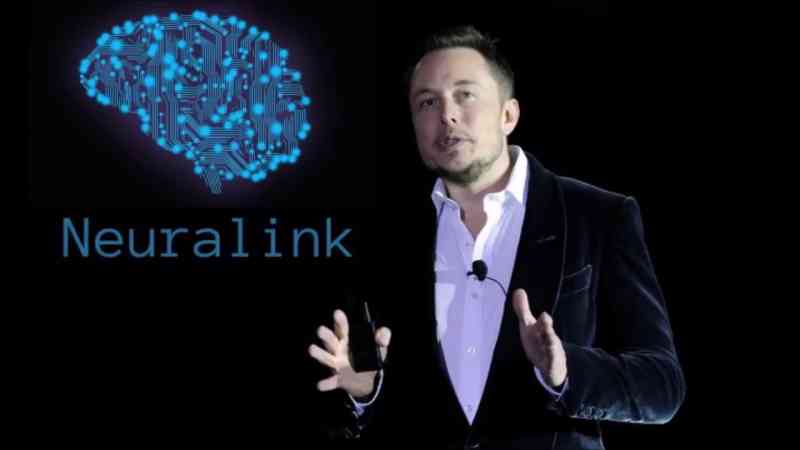How does it feel to be a James Bond villain? Try Apple’s new headset
I’m in a smart shopping mall in Texas, the kind of place that is called a “village”, where you feel out of place if you’re not wearing rimless glasses and a fleece. I’m not, which may explain why three ladies I stop to talk to at a café think, at first, that I am going to ask them for money.
None of this matters for the moment, though, because I am soon, in a sense, somewhere else — I’m perched here on a bench, but it appears to me that I am inside a smart but empty conference room, in some sort of office building, going over a slide presentation about a pedestrian bridge. How? Because I am hard at work in my Apple Vision Pro headset.
• Apple Vision Pro release: could VR spell the end for smartphones?
You may have seen pictures of this gadget, which looks like a silver pair of bulbous ski goggles. It has been on sale in America for a month. People have bought it and made strange social media videos. Some have returned theirs, saying it is too heavy, or uncomfortable, or that it induced headaches or nausea.
But here is one of its selling points that I am testing now: you can be anywhere — on the bus, train, in a shopping mall in Houston — and still feel as if you are in the office. Remote working allowed us to leave our offices: now our office is coming after us.
The headset is very James Bond villain. It has cameras that film the world around you and livestreams that appear on the screen inside your goggles. So you can look at the world as it is, more or less, with occasional glitches and fuzzy patches.
It’s not quite as good as the wonderful, five-star-reviewed, atomic-level sharpness you get by looking at the world without wearing the goggles. But added to the world, hanging in the air in front of you, as it were, are tabs and apps that you can open by staring at them and making a pinching gesture with a finger and thumb. Reality is now the wallpaper for your files and your internet browser.
Wearing the goggles, you can watch immersive films that place you in the middle of the action or skim through your photographs, enlarging them with your fingers so that last night’s dinner or a picture of your weird mole seem to hang in the air in front of you, large as Rothko paintings in an art gallery.
But you can also pass over these fripperies and roll up your sleeves and focus on work, a presentation about a pedestrian bridge, say. That is what I am doing. An Apple employee called Emelin, who is showing me how to use the headset, gets me to enlarge a slide showing a rendering of the bridge: a rather modern design with swirling lines and struts and ribs.

Emelin has an iPad linked to the headset so that she can see what I am seeing, except that she sees it on a flat screen while I am inside it, so to speak, with open tabs and windows hanging in the air above my head. I am like Mike Teevee in Charlie and the Chocolate Factory, walking around inside the television set.
I select a button on one of the slides and a three-dimensional model of the bridge detaches from the diagram to hang in the air in front of me.
• Apple Vision Pro review — I tried the VR headset and was lost for words
I reach out to pinch each end to make it larger, and as I do this I accidentally set it spinning slowly in the air. It’s rather nice to look at, revolving like this. I try turning it, until it is standing on its end, then give it another spin, so that it begins to turn end over end, like a villain’s car in an action film.
People wander past. A man has a very loud conversation on his phone, in Spanish, behind me. I continue spinning the bridge, reaching out with a finger and thumb to make it turn faster. Yes, I’m engrossed in this presentation. To the couple on a bench across from me, it must look as if I am playing an imaginary game of darts.
The bridge is whipping around like a Catherine Wheel now. Any pedestrians on it would be suffering from severe nausea and possible unconsciousness. I give it another flick. Who knew civil engineering was this much fun? I could do this all day. “Um, shall we move on?” Emelin asks.
Not long after the headset was released in stores, a TikTok video circulated of a chap striding across a road wearing one. He stopped in the middle of the street, reached up into the air with one hand and made a pinching motion. Then he flicked his hand sideways. He looked like a man on a dance floor, towards the end of the evening, after several drinks.
I know what he was up to now. He was probably closing a window or a tab. Or opening one. It was like that moment about seven years ago when small wireless headphones became widely available and you saw someone approaching you on the pavement saying: “You need to step up, OK? Why is it always me?” and gesticulating wildly. Your first thought was to cross the road. Then you realised they were on the phone, having a perfectly normal conversation with their husband.
At least with the goggles, people can see why you might be waving your hands in the air. Do you look as if you have lost your marbles? Yes. But that is the price you pay, sometimes, for staying at the cutting edge of spatial computing. For wearing a computer on your face. That and the literal price of $3,500.
When you first put it on, you play a little game to calibrate the machine. Round spots in pastel shades appear in a circle in front of you, each one with a white circular button in the middle. When you look at the white button, it grows slightly larger. You feel like the Terminator or Superman, with laser beams in your eyes. Then, with a pinching motion, with your index finger and your thumb, you extinguish each one.
“You don’t have to reach up and do it,” Emelin says. Because I was trying to wrap my finger and thumb around each one. “Your arms will get tired that way.”
The headset is covered in cameras that recognise the pinching gesture, wherever you do it. So you can sit with your hands in your lap, pinching to open and close tabs and folders, looking like an enthusiastic lobster, but you don’t have to reach for the sky and throw shapes, like that chap in the TikTok video.
When I stop spinning the pedestrian bridge, Emelin gets me to open another tab. This is the one that plants me in the conference room. “Look behind you,” Emelin says. I do and there is the slide about the pedestrian bridge, on a big board.
The conference room is panelled with yellow wood and there is a large wooden table, and sumptuous padded chairs all around it. They are empty. I have to admit I was rather pleased about this, as it seemed like an opportunity to spend more time spinning the bridge around. I presumed this meeting room was to allow for meetings with other people wearing the headsets.
Emelin says this is not so. It is merely a three-dimensional environment in which one can practise giving slide presentations, even if one is sitting in a shopping mall.
She gets me to click on another tab. Now I’m on the shore of a dark blue lake looking across the water at a gorgeous white-capped mountain. Emelin says it is Mount Hood, in Oregon. Behind me, when I turn around, there’s the edge of a forest that extends around the shore of the lake.
This is another work environment, Emelin says. You can open news stories and windows and files and leave them scattered all over the place. You can put them in the sky, or in the trees behind you. I can still hear people wandering by, and snatches of conversations as they pass, but they all feel a little more remote. I am in Oregon now, with my work. Reality, the shopping mall, is only an auditory hallucination.
There are more glamorous selling points for the goggles. The immersive cinema is stunning: it can put you on the crossbar of a football match as it is rattled by a shot, or on a cord strung over an abyss as a slackliner walks towards you, her breathing ragged, flinging up one hand to balance. Nature documentaries, in this thing, will be phenomenal.
But will they be more than an entertainment device? Steve Caruso, a digital designer at a Brooklyn studio, told the Wall Street Journal recently that being in the goggles was “just having an infinite number of iPads to pull out for work”.
• Mark Zuckerberg: Apple Vision Pro VR headset is too expensive
And no longer would you be distracted by your office mates. No longer would it matter if your office were a drab, grey, windowless cubicle, for you would be on a lake shore in Oregon, with a view of Mount Hood. It’s a corporate version of The Matrix. Large companies, so the argument went, would buy these for their staff, so they could all beaver away in their little virtual worlds.
Complaints about headaches, neck aches and nausea have raised doubts, naturally. And I’m not sure that other people and the outside world are more distracting than, say, new emails, social media notifications, and all the things inside our computers. “Do you want to buy a pair?” Emelin asks when I take them off.
I tell her I’ll think about it. I have that hyper-alert feeling you get, stepping out after hours in the cinema. It’s a sunny afternoon. The sunshine is glinting off a glass building, still under construction, across the road. There’s the smell of fine perfume, expensive fleece jackets and exhaust fumes. Cars are purring past along a highway that is lined with palm trees. It all looks fabulous.






